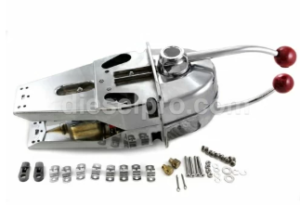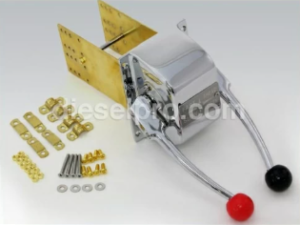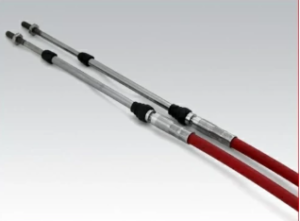Disassembly Of Throttle Controls For Detroit Diesel 71 Series Inline Engine (271, 371, 471, 671)

The throttle controls are an essential part of the engine’s operation, regulating the amount of fuel and air that enters the combustion chamber. Disassembling the throttle controls must be done carefully to avoid damage to sensitive linkages, springs, and cables. Proper removal is necessary during engine overhauls or when servicing the throttle components.
Safety Precautions

- Disconnect the Battery
- Before beginning any work on the throttle controls, disconnect the battery to prevent accidental engine start-up. This ensures there’s no electrical power running through the system while working on the throttle mechanism.
- Before beginning any work on the throttle controls, disconnect the battery to prevent accidental engine start-up. This ensures there’s no electrical power running through the system while working on the throttle mechanism.
- Wear Safety Gear
- Always wear safety goggles and gloves when working on the throttle control system to protect yourself from any unexpected movement of linkages or springs.
- Always wear safety goggles and gloves when working on the throttle control system to protect yourself from any unexpected movement of linkages or springs.
Disassembly Steps

-
Identify and Label Throttle Linkages:
- The throttle controls are connected to a series of linkages that connect the throttle pedal or lever to the engine’s fuel system. Before removing any components, label each linkage with tags to ensure that they are reconnected properly during reassembly. This will help prevent throttle control issues when the engine is put back into service.
- The throttle controls are connected to a series of linkages that connect the throttle pedal or lever to the engine’s fuel system. Before removing any components, label each linkage with tags to ensure that they are reconnected properly during reassembly. This will help prevent throttle control issues when the engine is put back into service.
-
Disconnect the Throttle Cable or Linkage
- Depending on the engine setup, the throttle is operated by either a mechanical linkage or a throttle cable. Disconnect the throttle cable from the throttle lever or fuel injection pump:
- Mechanical Linkage: If the throttle is controlled by a mechanical linkage, carefully disconnect the linkage from the throttle lever. Some linkages are secured with cotter pins or clips, so remove these using needle-nose pliers.
- Throttle Cable: If the engine uses a throttle cable, loosen the adjustment nuts on the cable housing and remove the cable from its bracket. Disconnect the cable from the throttle lever or fuel injection pump.
- Depending on the engine setup, the throttle is operated by either a mechanical linkage or a throttle cable. Disconnect the throttle cable from the throttle lever or fuel injection pump:
-
Remove the Throttle Control Lever
- The throttle control lever is typically mounted on the side of the engine or connected to the fuel pump. To remove it:
- Use a wrench or socket set to remove the fasteners securing the throttle control lever to the engine.
- Gently lift the throttle lever away from the engine, ensuring that no linkages or springs are damaged during removal.
- The throttle control lever is typically mounted on the side of the engine or connected to the fuel pump. To remove it:
-
Disconnect Return Springs
- Most throttle systems have return springs that help reset the throttle to its idle position when the throttle lever or pedal is released. These springs need to be disconnected carefully:
- Use pliers to remove the throttle return spring from its attachment points on the engine and throttle lever. Be mindful of spring tension, as the spring may snap back when released.
- Label or mark the springs to ensure they are reinstalled correctly during reassembly.
- Most throttle systems have return springs that help reset the throttle to its idle position when the throttle lever or pedal is released. These springs need to be disconnected carefully:
-
Inspect Throttle Components
- With the throttle control system disassembled, inspect the following components for wear or damage:
- Throttle Cable: Check the throttle cable for fraying, kinks, or stiffness. A damaged or worn cable should be replaced to ensure smooth throttle operation.
- Throttle Lever: Inspect the throttle lever for signs of wear at the pivot points. If the lever is loose or shows excessive play, it may need to be repaired or replaced.
- Linkages and Return Springs: Check the linkages and springs for rust, wear, or damage. Replace any worn or damaged components to ensure smooth throttle response.
- With the throttle control system disassembled, inspect the following components for wear or damage:
Reassembly Notes

-
Reinstall Throttle Linkages and Cable
- When reassembling, ensure that all linkages and cables are routed correctly and are free from binding. Use the labels placed during disassembly to reconnect each linkage and cable to the correct components.
- If you replaced the throttle cable, adjust the tension to the manufacturer’s specifications to ensure smooth operation and proper throttle response.
-
Reconnect Return Springs
- Carefully reinstall the throttle return springs in their correct positions. Make sure the springs are tensioned correctly so that the throttle lever or pedal returns to the idle position smoothly without sticking.
- Carefully reinstall the throttle return springs in their correct positions. Make sure the springs are tensioned correctly so that the throttle lever or pedal returns to the idle position smoothly without sticking.
-
Check for Smooth Operation
- After reassembly, manually operate the throttle lever or pedal to ensure the throttle opens and closes smoothly without sticking or binding. Make any necessary adjustments to the cable or linkages before starting the engine.
- After reassembly, manually operate the throttle lever or pedal to ensure the throttle opens and closes smoothly without sticking or binding. Make any necessary adjustments to the cable or linkages before starting the engine.
Additional Tips

- Lubricate Linkages: Use a light lubricant on the throttle linkages and pivot points to ensure smooth operation and reduce wear over time.
- Inspect Pivot Points for Wear: If the pivot points on the throttle lever or linkages are excessively worn, they may cause poor throttle response or binding. Replace worn components to restore proper function.
- Check Cable Routing: Ensure the throttle cable is routed away from any heat sources or moving parts that could cause wear or damage.
Parts Catalog for Detroit Diesel 271 Marine Engine
Parts Catalog for Detroit Diesel 371 Marine Engine
Please follow and like us:



 Free US Calls: 1-888-433-4735
Free US Calls: 1-888-433-4735 International: 305-545-5588
International: 305-545-5588